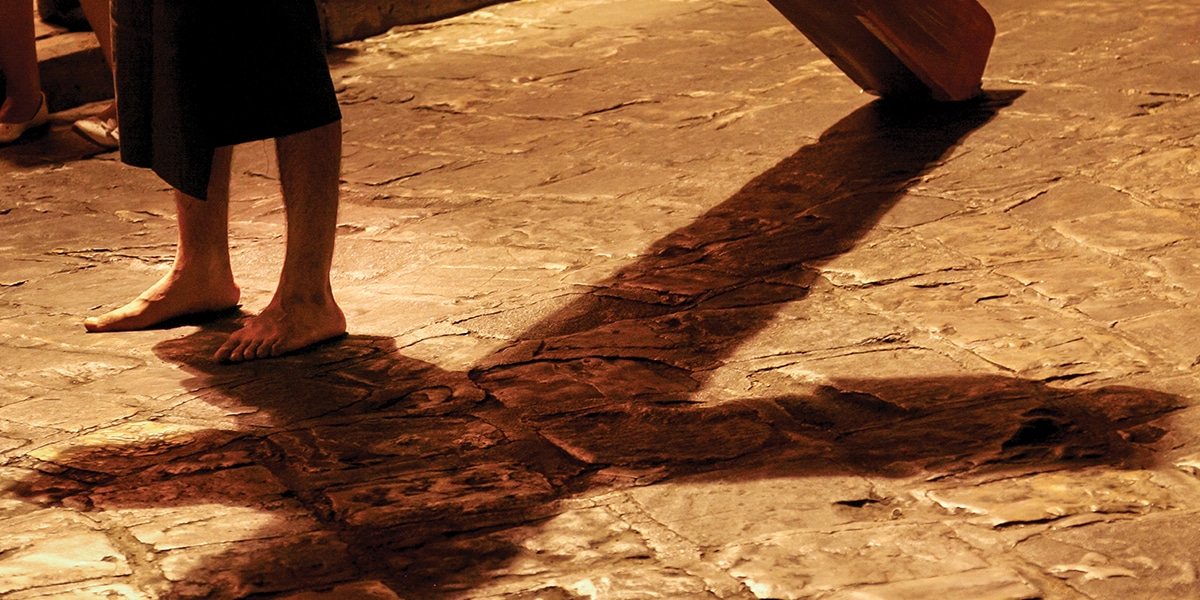Etched on the back of my mother’s headstone are three simple prayers: “Lord, live in me, love in me, and act in me.”
Adapted from Clarence Enzler’s Everyone’s Way of the Cross, these prayers not only perfectly describe my mother’s life, which ended suddenly in February 2021, but also echo a ritual she loved during Lent: the Stations of the Cross.
My family religiously attended “Stations,” as we called it, every Friday during Lent throughout my youth. Honestly, I didn’t get it. The Stations of the Cross—14 scenes marking Jesus’ journey to the crucifixion—felt like a terribly depressing story that always ended the same. What was the point? But I liked that it was only a half hour, and it came with tomato soup and garlic bread in the school cafeteria afterward. My parents, on the other hand, loved the Stations so much that they snagged Enzler’s book from the parish foyer so they could practice outside of Lent. It’s not really stealing, I guess, if it helps you pray.
As I got older, I stopped going to the Stations. I got my degree. I started my career. I moved south. I attended several nondenominational churches. Authors like Thomas Merton and Henri Nouwen resurrected for me rich contemplative practices in Catholicism I had long misunderstood. Still, the Stations remained something yet to be rediscovered on my spiritual walk.
When Mom’s life was ripped from us last year, one of the few things I remember from that week—of awakening day after day in the middle of a nightmare—was gathering in the warmth of my family’s living room on a snowy, Indiana day. We were weary from shock and tears, but Dad, with great strength and humility, took out his and Mom’s worn book and dared to read through Everyone’s Way of the Cross.
It all came rushing back. Why was this form of prayer so beautiful? What was it about the Stations that meant so much to my mother? We never got the chance to ask her.
Prayerful Gaze
Early Franciscans were moved by Jesus’ journey to Calvary as well. St. Francis, St. Clare, and Angela of Foligno all practiced gazing upon the crucifix as a form of contemplative prayer. It’s likely their imaginations were stirred to intimately experience different moments on the road to Jesus’ crucifixion.
Their prayerful stance led to an embodied faith, as they were moved to let the Lord live in them, love in them, and act in them, as receive the stigmata. All of this might be why the word Incarnation is a uniquely Franciscan term. Loving service and humble obedience become increasingly more natural to us when we place our “mind before the mirror of eternity,” as St. Clare encourages.
Perhaps because of St. Francis’ emphasis on the Incarnation, Franciscans began erecting the Stations in different places for prayer. By the 18th century, permission was granted to erect the Stations in churches as long as they were built by Franciscans and approved by a bishop. Today I wonder: What am I building in my own inner sanctuary? Am I erecting sacred statues that inspire a prayerful gaze as I carry my own cross or selfish idols that distract?
14 Steps
As I reflect upon my mother’s life, I’m moved by how she carried her own crosses. I wonder how the Stations may have influenced that journey, perhaps without her even knowing it. Ritual has a way of getting deep in your bones, the truest form of prayer. Mom struggled for decades to “feel anything” at Mass, yet that spiritual desert never stopped her from going, nor from praying the Stations.
Her life was marked by humble obedience and small acts of kindness each day. She took Enzler’s prayer to heart: “Lord, make me realize that every time I wipe a dish, pick up an object off the floor, assist a child in some small task, or give another preference in traffic or the store; each time I feed the hungry, clothe the naked, teach the ignorant, or lend my hand in any way. . . . The kindness I extend to them I really give to you.” A couple weeks before Mom passed away, she caught herself “overhelping,” as she sometimes did, and laughed, “Oh, misguided helpfulness,” a phrase from Enzler’s book.
Mom was never one for deep spiritual or philosophical conversations, but she, like the early Franciscans, modeled an embodied faith, where simple obedience to love’s daily call made her a cultivator of joy. I’m learning in my own darkness and depression that unpleasant feelings do not have to evoke avoidance but can, instead, deepen my values.
During that awful week a year ago, Dad texted my sisters and me a question about Mom’s burial. It was some kind of absurd logistical question you don’t fathom asking until much later in life, when your parents have had the opportunity to become grandparents. Dad misspelled cemetery, which autocorrected to veneration.
It’s silly, but I think about that a lot. As Enzler’s introduction in Christ’s voice invites: “My life was incomplete until I crowned it by my death. Your 14 steps will only be complete when you have crowned them by your life.”
Live, Love, Act
Lord, live in me—
as I dare to pick up my cross
and place one foot after
another.
Lord, love in me—
when my strength fades
and night stretches into
morning.
Lord, act in me—
embolden my will
and embody my being.
Amen.









1 thought on “Let Us Pray: Live in Me, Love in Me, Act in Me”
Please pray for me Derek Gerard Solomon
I’m suffering persecution
INRI
IHS